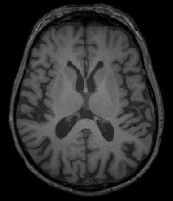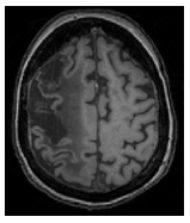1) Predicting death and dementia using an MRI
Predicting death and dementia in older stroke survivors using magnetic Resonance imaging(MRI)
If you click on an underlined word, it will take you to the glossary. From here you can scroll to the definition.
Quick-read Summary:
- Scientists can measure the size of the medial temporal lobe and this can tell us if there is brain damage. The medial temporal lobe is found in the middle of the brain.
- A smaller medial temporal lobe (scientists call this medial temporal atrophy) suggests that there has been brain damage.
- This research found that in people who have had a stroke, those with a smaller brain developed dementia and died sooner than those with bigger sized brains.
- Brain tests tell us how well our brain is functioning. People with brain function test scores that were lower than normal for somebody of that age, also developed dementia and died sooner.
- Scientists could use an MRI scan or brain test to find people who are at a higher risk of death and dementia.
The aim for this study
Is it possible to see signs of dementia by an MRI brain scan? An MRI is a way that we can take a detailed picture of the brain.

This is an MRI scan of a healthy brain

This is an MRI scan of a brain affected by a stroke
Why are we doing this study?
Previous work has shown that a stroke can increase the chance of developing dementia. Researchers found that the part of the brain called the medial temporal lobe can shrink (the medical term for shrinkage is atrophy). This is called medial temporal atrophy (MTA). Scientists believe this could be one of the reasons why people develop dementia.
What we did
-We studied 106 people over the age of 75 after a stroke.
-At the start, we took one brain scan (MRI) for each person. In total there were 106 MRI scans.
-Next, we conducted a brain test on the 106 people every year until they died. This brain test is called a ‘Cambridge Cognitive Examination’ (CAMCOG) and tells scientists how well the brain is functioning. We did these brain tests by asking them questions.
-Finally, we followed these people for up to 8 years. We looked at the brain scans and brain tests scores to see if there was a link between these and when the person developed dementia and when they died.
What did we find?
- Those whose medial temporal lobe had shrunk the most developed dementia sooner and also died sooner than those whose medial temporal lobe had not shrunk as much.
- People with lower brain test scores, (compared to scores from people without a stroke of the same age) developed dementia and died sooner than those with higher brain test scores.
- Brain shrinkage in the medial temporal lobe (MTA) was the best predictor of time until death.
What is the key message?
This study looked at people who had already had a stroke. People whose brain scan showed more shrinkage also did less well in the brain tests (CAMCOG). These people were more likely to die early and develop dementia than those whose brains showed less shrinkage.This means scientists could use either MRI brain scans or a brain test (CAMCOG) to find people at higher risk of death and dementia.
If you would like to know more about the risk factors for stroke and dementia, please click here.